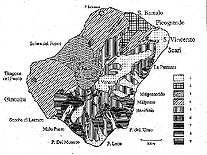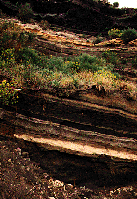| Stromboli
home page |
||
| Geography | Geological Evolution | Eruptive history |
| Volcanic Hazards | References | Web sites |
Geological evolution of Stromboli
 Geological sketch map of Stromboli island, from Hornig-Kjarsgaard et al. (1993). Click on thumbnail to view large version and legend. |
||
|
|
In the stratigraphy of Hornig-Kjarsgaard et al. (1993) and on the geological map of Stromboli by Keller et al. (1993), the following volcanostratigraphic units are identified:
- Strombolicchio
- 1) Strombolicchio eroded volcanic neck
- Paleostromboli
- 2) Lower Paleostromboli (PST) I lavas
- 3) PST I Pyroclastic Series
- 4) Upper PST I lavas
- 5) Lower Rina lavas
- 6) Omo lavas
- 7) Vallone Rina-Malo Passo Pyroclastics
- 8) Middle Vallone di Rina lavas
- 9) Upper Rina Lavas
- 10) Aghiastro lavas and pyroclastics
- 11) Cavono pyroclastics
- 12) Diatreme vent of Malo Passo
- Vancori and Scari
- 13) Lower Scari Tuffs (LST)
- 14) Scari Lava
- 15) Upper Scari Tuffs (UST)
- 15a) Lower Vancori and Middle Vancori Pyroclastics
- 16a, b) Lower Vancori (Lower Vancori-a) and Frontone lavas (Lower Vancori-b)
- 17) Middle Vancori lavas
- 18) Upper Vancori breccias
- 19) Upper Vancori lavas
- 20) Frontone breccias
- 21) Roisa scoriae and lavas
- Neostromboli
- 22) Neostromboli lavas
- 23) Timpone del Fuoco lavas
- 24) Labronzo lavas
- 25) Nel-Cannestrà lavas
- 26) Lazzaro pyroclastics
- Recent Stromboli
- San Bartolo lavas
- Pizzo sopra la Fossa pyroclastics
- Sub-recent Sciara lavas
- Recent Sciara activity
- Epiclastic volcanic materials
A fine, well-designed series of pages showing the geological evolution of Stromboli is available at Stromboli On-line.
.
Copyright © Boris Behncke, "Italy's Volcanoes: The Cradle of Volcanology"
Page
set up in late 1995, last modified on 12 February 2000

